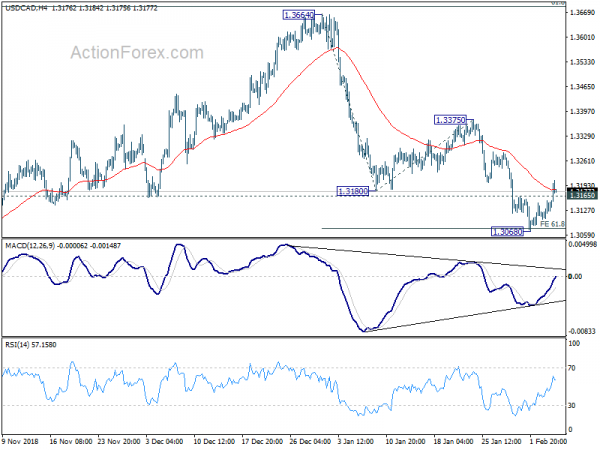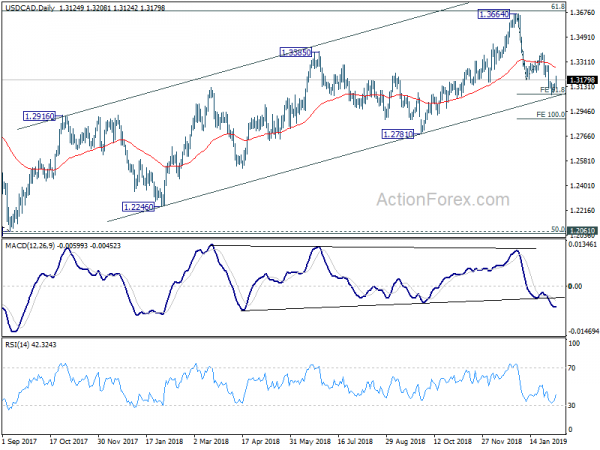Dollar is taking a breather for in early US session but remains the strongest one for the week. Positive development on trade talk with China is providing some support to the greenback, except versus Yen, which is the strongest for today. Sterling is also trying to recover after this week’s selloff. There is no clear solution on Irish backstop, just spats between EU and the UK. Meanwhile, Australian Dollar remains the weakest as selloff is extending,
Technically, USD/CAD’s break of 1.1365 minor resistance suggests short term bottoming at 1.3068. The outlook of EUR/USD, GBP/USD, USD/CHF, AUD/USD and USD/CAD are now aligned. That is, more upside is now in favor in Dollar in general. The only expectation is Yen. EUR/JPY and GBP/JPY are gyrating lower and focus could now be on 124.36 and 140.62 minor support levels respectively.
On the data front, US trade deficit narrowed to USD -49.3B in November, versus expectation of -54.0B. Canada building permits rose 6.0% mom in December versus expectation of -0.4% mom. Germany factory orders dropped -1.6% mom in December, versus expectation of 0.3%.
In other markets, currently, FTSE is down -0.06%, DAX is down -0.34%, CAC is down -0.10%. German 10-year yield is down -0.009 at 0.164. Earlier in Asia, Nikkei closed up 0.15% at 20875.63. Japan 10-year JGB yield is down -0.0062 at -0.015, staying negative. China, Hong Kong and Singapore were still on lunar new year holiday.
US Mnuchin putting enormous amount of effort to meet China trade talk deadline
US Treasury Secretary confirmed that he and US Trade Representative Robert Lighthizer will travel to Beijing next week for trade negotiations. Mnuchin said prior meetings with Chinese Vice Premier Liu He in Washington were “very productive”.
He added that he and Lighthizer are “committed to continue these talks”. And, “We’re putting in an enormous amount of effort to try to hit this deadline and get a deal. So that’s our objective.”
Mnuchin also said “we are also very focused on free and fair trade for U.S. companies to have access there and to having a more level playing field which will bring down the trade deficit.”
His comments echoed Trump’s remark in the State of Union Address that the trade deal “must include real, structural change to end unfair trade practices, reduce our chronic trade deficit and protect American jobs.”
EU Tusk: Won’t gamble with peace and no time limit of Irish backstop
In a joint press conference with Irish Prime Minister Leo Varadkar, European Council President Donald Tusk reiterated that the EU won’t re-open Brexit withdrawal agreement negotiation. Though he hoped that UK Prime Minister Theresa May would bring “realistic suggestions” to Brussels tomorrow. Tusk also emphasized that EU won’t “gamble with peace” by accepting a time limit on the Irish border. He admitted that Brexit will clearly happen as there no “leadership for remain. The priority now is to avoid no-deal, and safeguard an open Irish border.
Tusk also said “I’ve been wondering what the special place in hell looks like for those who promoted Brexit without even a sketch of a plan on how to carry it out safely.” Brexiteer Nigel Farage responded: “After Brexit we will be free of unelected, arrogant bullies like you – sounds like heaven to me.”
Verhofstadt tweeted, “Today I see Taoiseach Leo Varadkar and tomorrow Prime Minister May. My message to the UK will be that it is not very responsible to try to get rid of a backstop that is meant as an ultimate safeguard to avoid a hard border and the return of violence on the Island of Ireland.”
Separately, UK Trade Minister Liam Fox said a no-deal Brexit could force the government to drop all import tariffs in key sectors. The government have to consider the options to keep prices down for consumers and balance the impact on the job markets. For example, Fox said “in the agricultural sector it’s very clear what the impact would be were we to move to zero tariffs.”
Cabinet Office Minister David Lidington said that extending Article 50 would “simply defer the need for this house … to face up to some difficult decisions”.
Japan PM Abe and BoJ Kuroda defend monetary policy in parliament
Japan Prime Minister Shinzo Abe told the parliament today that the government accepted BoJ’s explanation on failing to meet the 2% inflation target. Abe went further and hailed that “what’s most important is what is happening to the economy as a result of the BOJ’s target, which is that more jobs were created.”
BoJ Governor Haruhiko Kuroda defended the central bank’s monetary policy to the parliament. He said “expanding base money alone won’t immediately have an effect on the economy”. And, “with huge expansion of base money, central banks can push down real interest rates and bank lending rates, which in turn would stimulate the economy.” He emphasized “this is what happened in the past six years.”
RBA Lowe: Evenly balanced chance of hike or cut in next move
Australian Dollar drops sharply after RBA Governor Philip Lowe dropped the rhetoric that the next move in interest rate is more likely a hike than a cut. Instead, he said the probabilities of hike and cut are now more “evenly balanced”. That is, rate cut is now back on the table.
Lowe delivered a speech “The Year Ahead” to the National Press Club of Australia today. Lowe maintained the view that ” tighter labour market and reduced spare capacity will see underlying inflation rise further towards the midpoint of the target range.” And given that, RBA “maintained a steady setting of monetary policy” yesterday.
However, he also noted given the uncertainties “it is possible that the economy is softer than we expect, and that income and consumption growth disappoint.” In particular, “in the event of a sustained increased in the unemployment rate and a lack of further progress towards the inflation objective, lower interest rates might be appropriate at some point.
Thus, on the scenarios of next-move-is-up and next-move-is-down, “the probabilities appear to be more evenly balanced.” Though Lowe also maintained that RBA “does not see a strong case for a near-term change in the cash rate”.
USD/CAD Mid-Day Outlook
Daily Pivots: (S1) 1.3101; (P) 1.3127; (R1) 1.3153; More…
USD/CAD’s rebound and break of 1.3165 minor resistance suggests short term bottoming at 1.3068, on bullish convergence condition in 4 hour MACD. Intraday bias is turned back to the upside for 1.3375 resistance first. Break should indicate completion of whole fall from 1.3664. In that case, further rise should be seen back to retest 1.3664. On the downside, in case of another fall, we’d stay cautious on bottoming as USD/CAD is close to channel support (now at 1.3061). But sustained break of the channel support will pave the way to 100% projection of 1.3664 to 1.3180 from 1.3375 at 1.2891.
In the bigger picture, structure of the medium term rise from 1.2061 (2017 low) to 1.3664 is not clearly impulsive. Hence, we’d stay cautious on strong resistance from 61.8% retracement of 1.4689 (2016 high) to 1.2061 at 1.3685 and 1.3793 resistance to limit upside, and bring medium term topping. But in any case, medium term outlook will stay bullish as long as channel support (now at 1.3049) holds. Sustained break of 1.3793 will pave the way to retest 1.4689 (2015 high). Firm break of the channel support should confirm reversal target 1.2061 low again.
Economic Indicators Update
| GMT | Ccy | Events | Actual | Forecast | Previous | Revised |
|---|---|---|---|---|---|---|
| 07:00 | EUR | German Factory Orders M/M Dec | -1.60% | 0.30% | -1.00% | -0.20% |
| 13:30 | CAD | Building Permits M/M Dec | 6.00% | -0.40% | 2.60% | 2.10% |
| 13:30 | USD | Trade Balance (USD) Nov | -49.3B | -54.0B | -55.5B | |
| 15:00 | CAD | Ivey PMI Jan | 60.2 | 59.7 | ||
| 15:30 | USD | Crude Oil Inventories | 1.3M | 0.9M |














